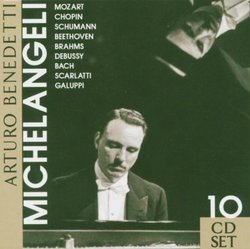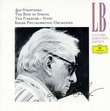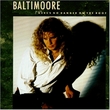| All Artists: Arturo Michelangeli Benedetti Title: Arturo Benedetti Michelangeli Members Wishing: 1 Total Copies: 0 Label: Documents Classics Original Release Date: 1/1/2006 Re-Release Date: 5/4/2006 Album Type: Box set, Import Genres: Dance & Electronic, Special Interest, Classical Styles: Opera & Classical Vocal, Ballets & Dances, Waltzes, Chamber Music, Forms & Genres, Ballads, Concertos, Fantasies, Sonatas, Suites, Historical Periods, Baroque (c.1600-1750), Classical (c.1770-1830), Modern, 20th, & 21st Century, Romantic (c.1820-1910), Instruments, Strings Number of Discs: 1 SwapaCD Credits: 1 UPC: 4011222230423 |
Search - Arturo Michelangeli Benedetti :: Arturo Benedetti Michelangeli
 | Arturo Michelangeli Benedetti Arturo Benedetti Michelangeli Genres: Dance & Electronic, Special Interest, Classical
|
Larger Image |
CD DetailsSimilar CDs
|
CD ReviewsThe Art of Michelangeli Simon | Paris, FRA | 11/09/2006 (5 out of 5 stars) "HIGHLY RECOMMENDED: This 10-CD set represents the recordings of the great Italian pianist Arturo Benedetti Michelangeli, from the maestro's earlier, post-World War years to the 1990's, spanning half a century of outsanding pianism and musicianship. Michelangeli was an eccentric, a truly special personality in the world of music who offered surprises and delights at every turn. His concert repertoire was insignificant and limited compared to those of his contemporaries Richter and Arrau, and he cancelled concerts at the slightest whims. His playing was equally unpredictable; it was at times extremely beautiful, colorful, and divinely expressive; on the other hand, it could also be robust, sturdy, and deafeningly powerful. His Debussy offered a transparent, watery atmosphere splashed with delicious sweetness and surreality, yet his Beethoven was direct and vigorous; his Chopin involved elements of both. Simply put, the art of Michelangeli was a fusion of sheer brilliance and an unmovable, forceful personality. The track listings are as follows: CD 1 - Wolfgang Amadeus Mozart (64:12) Concerto for Piano and Orchestra No.15 in B-flat Major, KV.450 Piano Quartet in E-flat Major, KV.493 CD 2 - Frédéric Chopin (76:48) Scherzo No.2 in B-flat minor, Op.31 Ballade No.1 in G Minor, Op.23 Andante spianato et Grande Polonaise Brillante in E-flat Major, Op.22 Berceuse in D-flat Major, Op.57 Piano Sonata No.2 in B-flat Minor, Op.35 Mazurka in F-sharp Minor, Op.59/3 Valse in E-flat, op. posth. CD 3 - Robert Schumann (57:45) Carnaval, Op.9 Faschingsschwang aus Wien, Op.26 CD 4 - Ludwig van Beethoven (72:05) Piano Sonata No.11 in B-flat Major, Op.22 Piano Sonata No.12 in A-flat Major, Op.26 Piano Sonata No.32 in C Minor, Op.111 CD 5 - Johannes Brahms (46:56) 4 Ballades, op.10 Variations on a theme by Paganini, Op.35 CD 6 - Claude Debussy (77:24) Children's Corner Images, Livres I & II Préludes, Livre I (9 Excerpts) CD 7 - Bach/Scarlatti/Galuppi (70:54) Chaconne in D Minor, BWV 1004 (trans. Busoni) Italian Concerto, BWV 971 Seven Sonatas Presto in B-flat major Sonata V in C Major CD 8 - Frédéric Chopin (70:36) Scherzo No.1 in B Minor, Op.20 Fantaisie in F Minor, Op.49 3 Valses 7 Mazurkas CD 9 - The Concertos in Vatican City for Pope John XXIII (63:56) Schumann: Piano Concerto in A Minor, Op.54 Liszt: Totentanz CD 10 - Schumann/Franck/Grieg (74:51) Piano Concerto in A Minor, Op.54 Symphonic Variations for Piano and Orchestra Piano Concerto in A Minor, Op.16" Excellent but obscure! Ian Vanhorne | 02/09/2007 (5 out of 5 stars) "I have all of michelangeli,s recordings on the bigger labels. deutsche grammopon,EMI these recordings are top rate. they are done from euro radio and tv shows. most all the matrial is from 1962-1990. the last disk was done in the forty's this disk is not very good but all the others are par excellence! the debussy images,the brahms.schumann,beethoven and most of the chopin,these recordings put the big labels to shame. this set is not a bargin its simply a giveaway! Buy it NOW!" A thousand carats musical gem! Hiram Gomez Pardo | Valencia, Venezuela | 08/17/2007 (5 out of 5 stars) "This is an anthological compilation that includes a series of priceless performances throughout the lifetime of this prodigious pianist of acclaimed status around the world.
Benedetti Michelangeli knew to achieve that coveted and praised sound in every one of his memorable appearances during his successful career. CD 1 : Wolfgang Amadeus Mozart Concerto for piano and orchestra no. 15 in B flat major with unknown date (but I guess this must have been recorded in the middle fifties), accompanied by Zurich chamber orchestra conducted by Edmond De Stoutz, and then comes the lovable Piano Quartet Kv. 493 with Jean Pierre Wallez, violin, Claude Henry Joubert, viola and Frank Dariel, cello. The performance of the piano Concerto matches with my favorite version of Geza Anda, sumptuous and hovered by that Imperial Dionysian breath, and the quartet is played with refined inspiration. CD 2: Frederic Chopin 1. Scherzo No. 2 Op. 31 2. Ballade No. 1 Op. 23 3. Andante spianato et Grand Polonaise Brillante Op. 23 Recorded in Bregenz March 1985 4. Berceuse O. 57 and 10. Valse in E flat Op. Posth. from Torino, December 1962 5. Sonata No. 2 was recorded in Lugano, June 4 1968 and finally from Brescia 23- 06- 67 the track 9 Mazurka Op. 59 No. 1 The first aspect to remark is the elevated lyric flight which was performed the First Ballad, I had never listened played with such cosmic approach and sheer lyricism, in my mind still resound the thundering visions of William Kapell or Teresa Carreño, for instance, but never under this mesmerizing gaze. Incorporeal, sublime and profound, breathes a grandness air never heard before. The Andante Spianato was performed, tinged of a celestial poetry, this always was one of the favorite pieces of this artist, played with sheer and devouring passion, but the superb expressiveness of Michelangeli literally covered the entire hall. And we have arrived to the jewel of the crown in this memorable CD; despite of the fact the Berceuse is simply insurmountable; the Sonata No. 2 acquires bindings of extraordinary its excel phrasing clarifies and accents accurately the inner pathos of this Op. Michelangeli overcomes himself respect to the previous version made in Praga in 1960. CD 3 . Robert Schumann Carnaval Op. 9 and Faschingsschwank Op. 26 To my mind there is not any other version capable to match with this inimitable, clean, fluid, evocative and superb performance, filled of surprising filigrees, carefully calibrated and expressed, in what it might realize about the perfect balance between expression and introspection. Every single episode is phrased with sublime excel precision .This performance dates from Lugano June 4 1968. CD 4: Ludwig van Beethoven. Recorded in Lugano in April 4 1981. The First Sonata is played with an amazing skillfulness, an outburst of effervescent energy and radiant luminosity that makes one regret he has not played more Beethoven during his lifetime. Maybe in what concerns to that ferocity and thundering accents the only pianist capable to match him has been Vladimir Horowitz, but Michelangeli is miles away him due his febrile gradation of tonalities and countless expressive resources. The twelfth Sonata is widely known, because its pristine elegance and lyric expression filled of magisterial hues. The First Movement is luminous and overwhelmingly phrased filled of Beethovenian pathos and Apollonian enjoyment. Although I feel the Marcia a mite fast and not so full rounded as Serkin did it in a recital from London 1971 (very difficult to get, by the way), his impeccable gifts surmount by far this simple detail. The Sonata No. 32 is superbly played, specially toward the last movement where Michelangeli makes one felt the evanescent effluvium of the fugue in its incorporeal nature and vanishing meaning. CD 5 Johannes Brahms This CD is part of a legendary recital which took place in Lugano on May 1973, previously released by music and Arts Cd 817 ( 2 CD), whose entire program was composed by Bach / Busoni Chaconne , Schumann Carnaval Op. 9 and then Brahms in the second half. Personally I have never listened such set of Ballades played with such sense of penetrating mystery and , incorporeal elusiveness and dark lyricism. He gives us a full rounded of magisterial domain of this socre and (at least to my mind) confirms a personal opinion in which these Ballades must be played as if each one of them be part of Sonata. Paganini variations was always part of Michelangeli in most of his appearances and it may be regarded one of his most beloved battle horses. Perhaps there are thre others performances worthy to amatch with this one; the extraordinary version of Kapell in a live performance (never released on commercial circuits) , Julius Katchen' s ravishing performance and finally an electrifying version of Gary Grafman, but this one is filled of magic rapture from the very start to his triumphal final coda. CD 6 Claude Debussy The formidable incorporeal approach to this well known and most beloved suite is amazing in every sense. Filled of nuance, humor, astonishing technique and poetic lyricism, matches only with three other versions Samson Francois, Robert Casadesus and obviously, Walter Gieseking. Jumbo's lullaby is played with such sheer poetry as you have never heard it before. This performance is adted from Lugano, June 1968 the Preludes Book one in Vatican City in 1977, and the rest of the recital was recorded in 1987. Has there been other pianist capable to express with major vehemence the Epicurean enjoyment of these Images with major interpretative eloquence? with Debussy Michelñangeli reached other pinnacle in what supreme perfection concerns. His sound creates an atmosphere of poetic enrapture as nobody else has been able to make it. On the other hand, the Preludes are true gems of collection. CD 7 Johan Sebastian Bach, Scarlatti and Baldassarre Galuppi The Chaconne (transcription of Busoni) has always been one of the great achievements of Michelangeli. The Italian Concerto is fresh and filled of a propulsive lyricism. His Scarlatti is perhaps extremely rational (to my personal taste) and Galuppi is mesmerizing. CD 8 CHOPIN This is one of the best items of this set; every one of these pieces is performed with conviction level and pristine elegance that nevertheless has nothing to do in which excess of romanticism, it's much more than that. It's the print of sensitive thinker in pursuit of the maxim idiomatic expression. CD 9 The Concertos in Vatican City for Pope John XXIII, 25 April 1962 Schumann and Liszt This is one of the most imaginative and prominent versions I have ever heard (and believe me I have heard more than one hundred different ones), it possesses that incandescent glitter and radiant lyricism without affectation. Totentanz finds in Michelangeli a true and formidable performer, his admirable technique, wonderful phrasing and refined éclat make of this version a must collect. There are fascinating details of orchestration in the minute 11:30 and suggestive music filigrees in the electrifying final coda Conductor. Gianandrea Gavazzeni. CD 10 Schumann., Franck, and Grieg Again Michelangeli plays Schumann 's Piano Concerto under the unforgettable baton of Dimitri Mitropoulos. Recorded in New York , November 1948 This performance lasts 70 seconds minus than the given on Vatican City, but its approach is entirely different, it's more dramatic and the passion is above the romantic mood . Cesar Franck `s Symphonic Variations was conducted by Alfred Wallenstein Conductor of the Angeles Philharmonic in 1949. Mesmerizing: Grieg's Piano concerto Op. 16 was played under the baton of Alceo Galliera and the Orchestra del Teatro alla Scala di Milano, conducted by Alceo Galliera in 1942. Simply sublime. " |

 Track Listings (6) - Disc #1
Track Listings (6) - Disc #1

